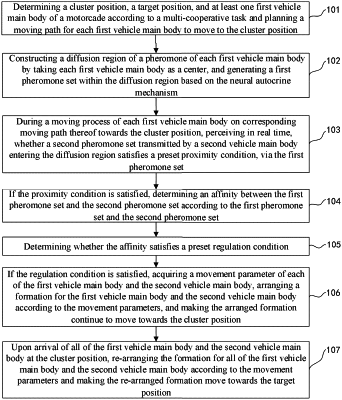| CPC G08G 1/20 (2013.01) [G08G 1/052 (2013.01); G16B 5/00 (2019.02); G16B 40/00 (2019.02)] | 20 Claims |

|
1. A neural autocrine mechanism based motorcade regulation method, wherein the motorcade regulation method comprises following steps:
determining a cluster position, a target position, and at least one first vehicle main body of a motorcade according to a multi-cooperative task and planning a moving path for each first vehicle main body to move to the cluster position;
constructing a diffusion region of a pheromone of each first vehicle main body by taking each first vehicle main body as a center, and generating a first pheromone set within the diffusion region based on the neural autocrine mechanism, wherein the first pheromone set comprises at least one first pheromone;
during a moving process of each first vehicle main body on a corresponding moving path thereof towards the cluster position, perceiving in real time, whether a second pheromone set transmitted by a second vehicle main body entering the diffusion region satisfies a preset proximity condition, via the first pheromone set, wherein the second pheromone set comprises at least one second pheromone;
when the proximity condition is satisfied, determining an affinity between the first pheromone set and the second pheromone set according to the first pheromone set and the second pheromone set;
determining whether the affinity satisfies a preset regulation condition;
when the regulation condition is satisfied, acquiring a movement parameter of each of the first vehicle main body and the second vehicle main body, arranging a formation for the first vehicle main body and the second vehicle main body according to the movement parameters, with which the first vehicle main body and the second vehicle main body continue to move towards the cluster position; and
upon arrival of all of the first vehicle main body and the second vehicle main body at the cluster position, re-arranging the formation for all of the first vehicle main body and the second vehicle main body according to the movement parameters with which the first vehicle main body and the second vehicle main body move towards the target position.
|